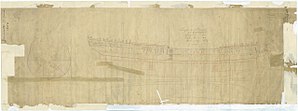 Plan of Yarmouth
| |
| History | |
|---|---|
| Name | HMS Yarmouth |
| Ordered | 16 June 1742 |
| Builder | Deptford Dockyard |
| Laid down | 25 November 1742 |
| Launched | 8 March 1745 |
| Commissioned | February 1745 |
| In service |
|
| Honours and awards | |
| Fate | Broken up, April 1811 |
| General characteristics [1] | |
| Class and type | 1741 proposals 64-gun third rate ship of the line |
| Tons burthen | 1359 38⁄94 bm |
| Length |
|
| Beam | 44 ft 3 in (13.5 m) |
| Depth of hold | 19 ft (5.8 m) |
| Propulsion | Sails |
| Sail plan | Full-rigged ship |
| Complement | 480 |
| Armament |
|
HMS Yarmouth was a 64-gun third rate ship of the line of the Royal Navy, designed and built by Joseph Allin the younger at Deptford Dockyard. She was previously ordered to the dimensions specified in the 1741 proposals for modifications to the 1719 Establishment, but the Admiralty had very quickly concluded that these were too small, and as an experiment in 1742 authorised an addition of 6 ft to the planned length, and Yarmouth was re-ordered to the enlarged design in June 1742. She was built at Deptford, where the Admiralty felt they could best observe the effectiveness of the added size, and launched on 8 March 1745.[1]
Commissioned in February 1745 under Captain Roger Martin. In 1747 under Captain Piercy Brett she was one of George Anson's squadron at the First Battle of Cape Finisterre.[1] Yarmouth became a guardship in 1763, serving alternately between Chatham and Sheerness. She was recommissioned for the Leeward Islands in 1777 and sailed on 9 September.[2] In 1781, Yarmouth was reduced in armament to become a 60-gun ship. She remained in this role until 1811, when she was broken up.[1]
On 22 January, 1778 she captured brigs "Fortune" and "Alexander" off Dominico.[3]